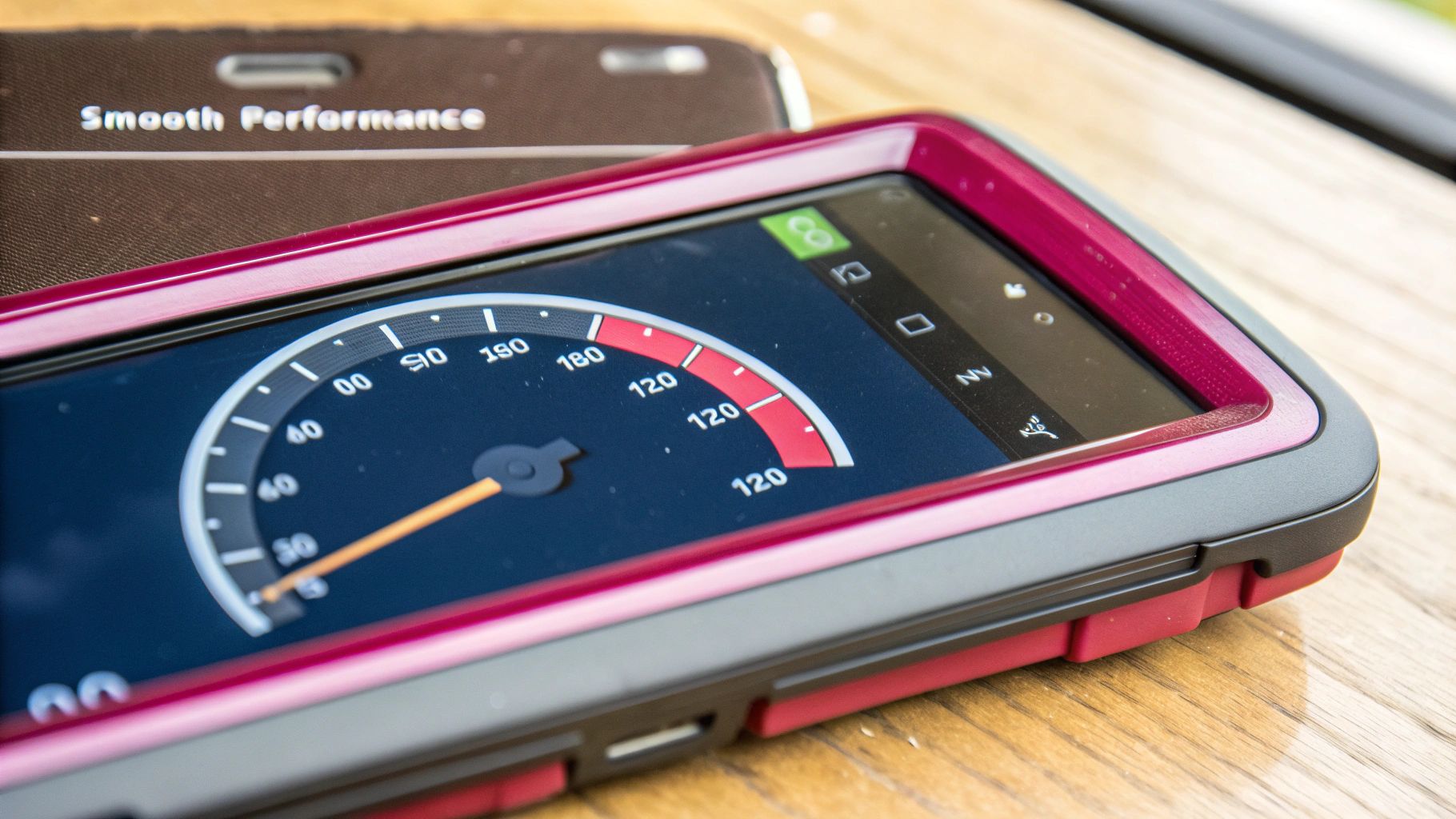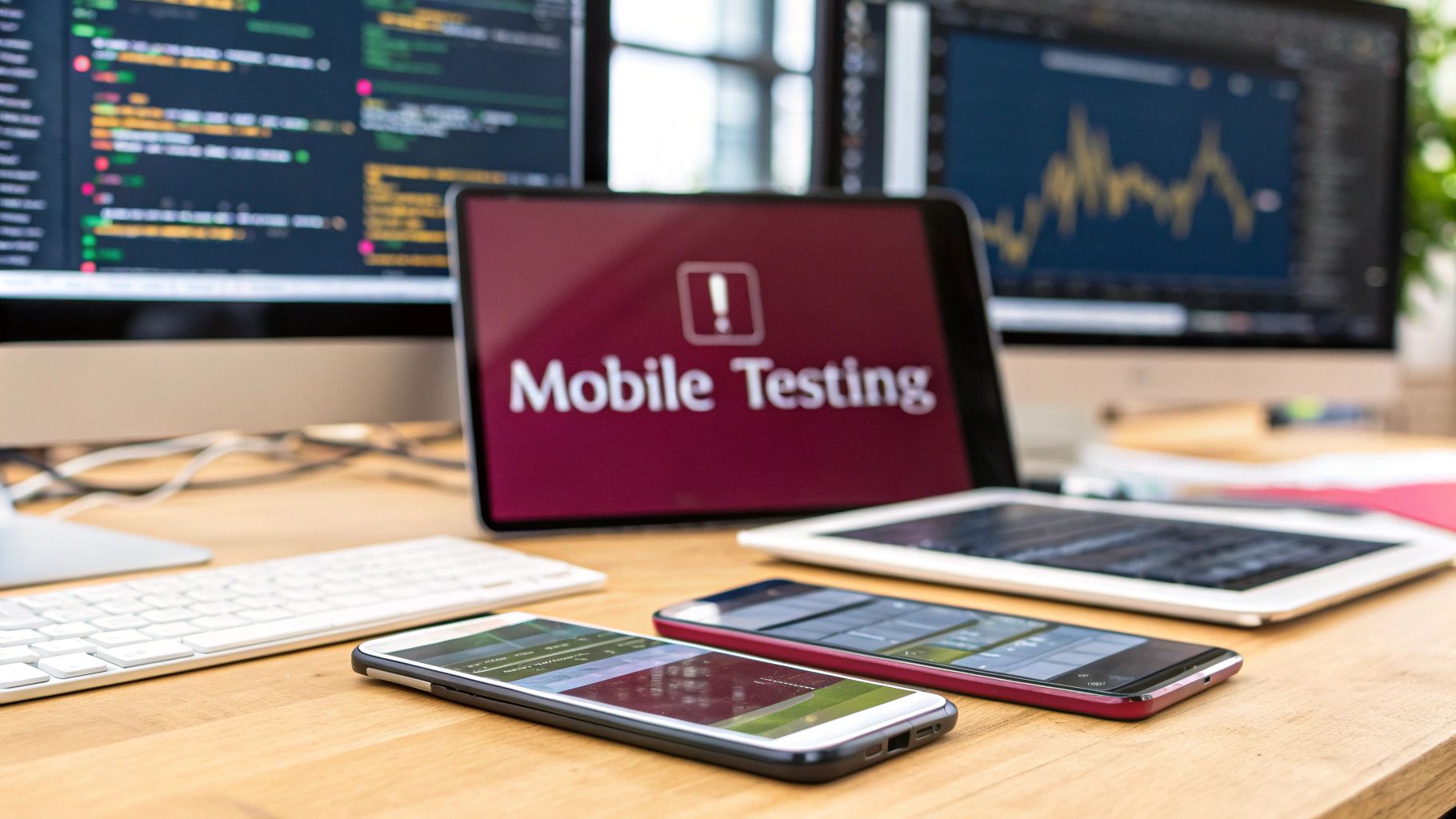In an app-centric economy, a flawless user experience is the difference between market leadership and obscurity. Yet, delivering this experience is fraught with complexity. Development and QA teams constantly grapple with a diverse device landscape, unreliable network conditions, and relentless pressure to ship features faster without sacrificing application quality. These persistent challenges in mobile application testing can derail release schedules and lead to poor user retention.
This article cuts through the noise. We will move beyond generic advice to provide a detailed, actionable guide to the seven most critical testing hurdles teams face today. You will learn specific strategies to navigate the complexities of device fragmentation, conquer network variability, and streamline your QA process for better, more reliable releases.
From managing performance on low-end devices to ensuring robust security, we provide practical solutions for each obstacle. We’ll explore how to handle platform-specific behaviors, simplify test automation, and perfect the user experience. By mastering these areas, your team can ensure your application not only meets but exceeds user expectations, securing its place in a competitive market. This guide provides the expert-level insights needed to build a resilient and effective mobile testing strategy.
1. Device Fragmentation
Device fragmentation stands as one of the most significant and persistent challenges in mobile application testing. It describes the vast and ever-expanding universe of mobile hardware and software configurations. Your application must function flawlessly across countless combinations of operating systems (Android, iOS), OS versions (Android 14, iOS 17), screen sizes, resolutions, and hardware specifications like CPU and GPU power. This diversity makes it nearly impossible to guarantee a consistent user experience for everyone without a strategic testing plan.

The Android ecosystem, with over 20,000 unique device models from manufacturers like Samsung, Google, and Xiaomi, is a prime example of this challenge. Even within Apple’s more controlled environment, developers must account for different screen sizes and hardware capabilities, from the compact iPhone SE to the powerful iPhone 15 Pro Max. Failing to address this can lead to UI rendering errors, performance bottlenecks, or critical crashes on specific devices, resulting in poor reviews and user churn.
How to Overcome Device Fragmentation
A comprehensive strategy combines data-driven prioritization with a mix of virtual and physical testing tools. It is not feasible to test on every device, so the goal is to maximize test coverage on the configurations that matter most to your user base.
Here are actionable steps to manage device fragmentation:
- Prioritize with Analytics: Use tools like Google Analytics or Mixpanel to identify the most popular devices, OS versions, and screen resolutions among your current users. Focus your primary testing efforts on these high-traffic configurations.
- Create a Device Matrix: Develop a testing matrix that maps device models and OS versions to your target markets and user demographics. This ensures your testing aligns with business objectives and market share realities. For instance, a banking app like Chase Mobile must ensure compatibility across hundreds of specific models to serve its broad customer base.
- Leverage Cloud Device Farms: Use cloud-based testing platforms like AWS Device Farm or BrowserStack. These services provide remote access to a massive library of real physical devices, allowing you to run automated and manual tests on configurations you don’t own. This is a cost-effective way to validate performance on a wide array of hardware.
- Combine Emulators and Real Devices: Start your testing cycles using emulators (Android Studio) and simulators (Xcode) for rapid, early-stage feedback on UI layout and basic functionality. However, always perform final validation, especially for performance and hardware-specific features, on real physical devices to catch issues that simulators cannot replicate.
2. Network Connectivity Issues
Ensuring an application performs reliably across inconsistent network conditions is another of the core challenges in mobile application testing. Unlike stable desktop environments, mobile users constantly transition between Wi-Fi, 5G, 4G, and even slower 3G networks. They also experience intermittent connectivity in tunnels, elevators, or rural areas, and may go completely offline. Your app must gracefully handle these fluctuations, from slow speeds to complete network loss, without crashing or losing user data.

The impact of poor network handling is significant. Consider an e-commerce app that fails to process a payment during a brief network switch, or a messaging app like WhatsApp that loses a user’s message instead of queuing it. Successful apps are built with resilience in mind. Spotify’s offline playback and Google Maps’ offline navigation are prime examples of features that deliver value even without an active connection, drastically improving the user experience and building user trust.
How to Overcome Network Connectivity Issues
A robust testing strategy involves simulating a wide range of network environments and validating the app’s behavior in each scenario. The goal is to ensure the application remains functional, responsive, and secure regardless of the user’s connection quality.
Here are actionable steps to manage network connectivity challenges:
- Use Network Simulation Tools: Employ tools like Apple’s Network Link Conditioner or Charles Proxy to simulate various network conditions. These allow you to test how your app behaves on slow 3G networks, high-latency connections, or with significant packet loss, all from a controlled development environment.
- Test Offline and Airplane Mode Scenarios: Manually enable airplane mode to verify that your app’s offline features work as intended. Test what happens when a user attempts an online-only action. The app should display a clear, user-friendly error message rather than freezing or crashing.
- Implement Caching and Data Sync Logic: Develop a strong caching strategy to store essential data locally. When connectivity is restored, your app should seamlessly sync local changes with the server. Testing this synchronization process is critical to prevent data loss or corruption.
- Validate Graceful Degradation: The app shouldn’t just work or fail; it should degrade gracefully. For instance, an image-heavy social media app like Instagram might load low-resolution placeholders on a slow connection before fetching the high-quality versions. It is also important to consider how network issues affect your deployment process; discover how a sound mobile app update strategy on CodePushGo.com can help mitigate these risks.
3. Performance and Memory Constraints
Unlike desktops, mobile devices operate with finite processing power, memory (RAM), and battery life. This creates significant challenges in mobile application testing, as applications must deliver a smooth, responsive experience without monopolizing system resources. An app that lags, drains the battery excessively, or crashes due to memory leaks will quickly be uninstalled. Performance testing, therefore, is not a luxury but a critical necessity to ensure usability across the entire device spectrum, especially on older or budget-friendly models.

High-performance apps are a testament to meticulous optimization. For example, Netflix optimizes video streaming codecs and buffering algorithms to deliver smooth playback on devices with varying network conditions and processing power. Similarly, gaming apps like PUBG Mobile dynamically adjust graphics settings to maintain playable frame rates on diverse hardware, from high-end flagships to entry-level phones. These examples highlight the need to balance rich functionality with resource efficiency to retain users.
How to Overcome Performance and Memory Constraints
A proactive and continuous approach to performance testing is essential. The goal is to identify and resolve bottlenecks early in the development lifecycle, preventing them from impacting end-users. This involves setting clear performance benchmarks and integrating profiling tools directly into your workflow.
Here are actionable steps to manage performance constraints:
- Profile Early and Often: Use native profiling tools like Xcode Instruments for iOS and Android Profiler for Android. These tools help you analyze CPU usage, inspect memory allocation, and identify performance bottlenecks in real-time as you build features.
- Establish Performance Budgets: Define strict performance budgets for key metrics like app launch time, memory usage, and battery consumption. For instance, set a goal that the app must launch in under two seconds on a mid-range device. These budgets should be monitored in your CI/CD pipeline to prevent regressions. You can explore the core app performance metrics on codepushgo.com to establish your baselines.
- Test on Low-End Devices: Do not limit your testing to the latest flagship models. Actively test on older and budget devices that are prevalent in your target markets. This is the only way to uncover issues related to limited RAM and slower processors that your primary development device might mask.
- Automate Performance Monitoring: Integrate automated performance tests into your continuous integration pipeline. Tools can be configured to run tests on every build, measuring key metrics and automatically flagging any degradation in performance before the code is merged.
4. Security and Privacy Testing
Ensuring robust security and user privacy is one of the most critical challenges in mobile application testing. Mobile apps frequently handle sensitive information, from personal identifiers and financial details to private health records. Testing must validate secure data handling, from storage and encryption to transmission, and ensure compliance with global regulations like GDPR and CCPA. A single vulnerability can lead to catastrophic data breaches, severe financial penalties, and irreversible damage to brand trust.

The stakes are exceptionally high across different industries. For example, a banking app must implement flawless multi-factor authentication and secure payment processing to meet PCI DSS standards. A healthcare app is legally bound by HIPAA to protect patient data with stringent access controls. Even social media apps face scrutiny, often implementing end-to-end encryption to protect user messages. Failing to address these security layers exposes users to risk and the business to legal action.
How to Overcome Security and Privacy Challenges
A proactive and multi-layered security testing strategy is essential. It requires integrating security checks throughout the development lifecycle, not just as a final pre-release step. This “shift-left” approach helps identify and remediate vulnerabilities early when they are easier and cheaper to fix.
Here are actionable steps to manage security and privacy testing:
- Follow the OWASP MSTG: Adhere to the OWASP Mobile Security Testing Guide (MSTG). It provides a comprehensive framework for identifying and mitigating common mobile vulnerabilities, such as insecure data storage, weak server-side controls, and improper platform usage.
- Automate with SAST and DAST: Integrate Static Application Security Testing (SAST) and Dynamic Application Security Testing (DAST) tools into your CI/CD pipeline. Tools like Veracode or Checkmarx can automatically scan code for known vulnerabilities (SAST) and test the running application for security flaws (DAST).
- Conduct Penetration Testing: Regularly hire third-party security experts to perform penetration tests and vulnerability assessments. These “white-hat” hackers simulate real-world attacks to uncover deep-seated vulnerabilities that automated tools might miss.
- Implement Secure Coding and Code Reviews: Enforce secure coding practices within the development team and conduct peer code reviews with a security focus. This helps prevent common vulnerabilities like SQL injection or cross-site scripting (XSS) from being introduced in the first place. You can learn more about 8 essential app security standards on codepushgo.com.
5. User Interface and User Experience Testing
Ensuring an intuitive and engaging user interface (UI) and user experience (UX) is another one of the core challenges in mobile application testing. This goes beyond just making sure buttons work; it involves validating that the app is easy to navigate, visually consistent, and accessible to all users. Testers must verify gesture controls like swipes and pinches, assess the clarity of navigation flows, and confirm that the visual design remains intact across various screen densities and orientations.
A poor UX can cripple an otherwise functional application. For example, an e-commerce app with a confusing checkout process or an app like Instagram with unintuitive photo editing tools will frustrate users and lead to high abandonment rates. Similarly, failing to meet accessibility standards can exclude a significant portion of the potential user base and may even carry legal risks. Validating the entire user journey, from onboarding to core feature interaction, is critical for retention and positive reviews.
How to Overcome UI/UX Testing Challenges
A successful UI/UX testing strategy blends automated visual validation with human-centric usability testing. The goal is to catch both objective design flaws and subjective user friction points before they impact your audience. This requires a multi-faceted approach that addresses visual consistency, usability, and accessibility.
Here are actionable steps to manage UI/UX testing:
- Implement Automated Visual Testing: Use tools like Applitools or Percy to automatically capture screenshots of your app’s UI across different devices and builds. These tools use AI to detect unintended visual changes, pixel-level inconsistencies, and rendering errors, saving countless hours of manual checking.
- Conduct Real-User Usability Testing: Go beyond your internal QA team and conduct usability sessions with individuals from your target demographic. Observe how they interact with the app to uncover confusing workflows, unclear navigation, and other friction points that developers and testers might overlook.
- Prioritize Accessibility: Integrate accessibility testing into your development cycle. Use tools like axe-mobile to scan for violations of WCAG (Web Content Accessibility Guidelines) and manually test with assistive technologies like screen readers (VoiceOver, TalkBack) to ensure a seamless experience for users with disabilities.
- Leverage A/B Testing for Improvements: Use A/B testing frameworks to experiment with different UI elements, layouts, or user flows. By measuring how these changes affect user behavior, you can make data-driven decisions that directly improve engagement. For a deeper understanding of what to measure, you can explore the key app engagement metrics on codepushgo.com.
6. Platform-Specific Behavior Testing
Navigating the distinct ecosystems of iOS and Android presents one of the most nuanced challenges in mobile application testing. This goes beyond simple UI differences; it involves accounting for unique platform behaviors, design guidelines, system integrations, and store compliance requirements. An application that feels native and intuitive on iOS might feel clunky and out of place on Android if its platform-specific conventions are ignored, even if the core functionality is identical.
This challenge is evident in how popular apps handle common features. For instance, Microsoft Teams displays notifications differently on each platform to align with user expectations, and social media apps must adapt their content-sharing mechanisms to use either the iOS Share Sheet or Android’s Intent system. Similarly, integrating payment systems requires separate implementations for Apple Pay and Google Pay. Neglecting these platform-specific details can lead to a disjointed user experience, negative reviews, and even rejection from the app stores for non-compliance with platform guidelines.
How to Overcome Platform-Specific Behavior Testing
A successful strategy involves creating distinct test plans that validate both shared core logic and unique platform features. This requires a deep understanding of each operating system’s architecture and user experience paradigms, ensuring the app feels at home on every device.
Here are actionable steps to manage platform-specific behaviors:
- Create Platform-Specific Test Cases: Develop separate test suites for iOS and Android that cover unique features. This includes testing navigation patterns (e.g., back button behavior on Android vs. swipe gestures on iOS), permission requests, and interactions with native system components.
- Test System-Level Integrations: Validate features that interact directly with the OS, such as Siri Shortcuts on iOS or App Actions and Intents on Android. Ensure deep linking and inter-app communication function correctly according to each platform’s standards.
- Utilize Native Testing Frameworks: Leverage platform-specific frameworks like XCTest for iOS and Espresso for Android to conduct granular, low-level testing of native UI components and interactions. This is crucial even when using cross-platform development tools like React Native or Flutter.
- Validate Store Guideline Compliance: Rigorously test your app against the latest Apple App Store Review Guidelines and Google Play Store policies. This includes checking privacy controls, data handling disclosures, and subscription models to prevent last-minute rejections during the release process.
7. Test Automation Complexity
Implementing effective test automation for mobile apps is a significant hurdle, presenting a unique set of challenges in mobile application testing. Unlike web automation, mobile test automation must contend with dynamic UI elements that change with OS updates, device-specific behaviors, and the inherent flakiness of interacting with native components. Building and maintaining stable, reliable automated test suites requires specialized tools, frameworks, and strategies that are fundamentally different from traditional desktop or web testing.
The complexity arises from needing to create scripts that work across diverse platforms like iOS and Android, which have different underlying architectures. For example, Airbnb uses frameworks like Appium to write cross-platform tests, but still must manage platform-specific locators and behaviors. A poorly designed automation strategy can lead to brittle tests that break with minor UI changes, creating a maintenance nightmare that consumes more resources than it saves and ultimately slows down the release cycle.
How to Overcome Test Automation Complexity
A successful mobile automation strategy focuses on creating resilient, maintainable, and scalable test suites. This involves choosing the right tools for your specific technology stack and implementing design patterns that reduce code duplication and improve stability. The goal is to build an automation framework that grows with your application, not against it.
Here are actionable steps to manage test automation complexity:
- Choose Appropriate Automation Tools: Select frameworks based on your app’s technology. Use Espresso for native Android apps and XCUITest for native iOS apps to get fast, reliable feedback. For cross-platform applications like those built with React Native, Appium is an excellent choice as it allows you to reuse test logic across both iOS and Android.
- Implement the Page Object Model (POM): Adopt the POM design pattern to separate UI interaction logic from test case logic. This makes your tests more readable and significantly easier to maintain. When a UI element changes, you only need to update its corresponding page object, not every test script that uses it.
- Use Proper Synchronization and Waits: Avoid using fixed delays (like
sleep(5)). Instead, implement explicit or implicit waits that pause test execution until a specific element is visible or a condition is met. This makes tests more stable by accounting for variable network speeds and device performance. - Integrate Automation into CI/CD: A key to unlocking the value of automation is integrating it into your continuous integration pipeline. For more insights on this, you can explore our guide to Android continuous integration on codepushgo.com. This ensures that tests are run automatically on every code commit, providing rapid feedback to developers.
- Start Small and Expand: Begin by automating critical “smoke tests” and “sanity checks” that cover your app’s core functionalities, like login or checkout flows. Gradually expand your automation coverage to include more complex scenarios, ensuring you build a solid and reliable foundation first.
Challenges Comparison Matrix of 7 Mobile Testing Issues
| Aspect | Device Fragmentation | Network Connectivity Issues | Performance and Memory Constraints | Security and Privacy Testing | UI/UX Testing | Test Automation Complexity |
|---|---|---|---|---|---|---|
| Implementation Complexity 🔄 | Very high: testing across many devices | High: simulating many network states | High: requires profiling on varied devices | High: involves specialized security tests | Medium-High: subjective & manual testing | Very high: complex setup, flaky tests |
| Resource Requirements ⚡ | Extensive device inventory, manual testing | Specialized tools for network simulation | Performance tools, diverse devices | Security tools, expert resources | User groups, automated visual tools | Automation tools, cloud platforms |
| Expected Outcomes 📊 | Broad compatibility, reduced device-specific bugs | Reliable app behavior in poor networks | Smooth performance, low battery/memory use | Secure data handling, regulatory compliance | Intuitive, accessible user experience | Stable, scalable, maintainable test suites |
| Ideal Use Cases 💡 | Apps with wide device range (Android, iOS) | Apps needing offline, sync, retry logic | Apps requiring smooth multi-device performance | Apps handling sensitive/personal data | Customer-facing apps prioritizing UX | Continuous integration and frequent releases |
| Key Advantages ⭐ | Better market coverage, fewer crashes | Improved usability under all network conditions | Enhanced user satisfaction via performance | Trust-building via security & compliance | Higher retention via user satisfaction | Faster feedback, fewer manual regressions |
Transforming Testing Challenges into a Competitive Advantage
Navigating the complex landscape of mobile app development requires a deep understanding of its inherent hurdles. Throughout this guide, we’ve dissected the most significant challenges in mobile application testing, from the sheer diversity of device fragmentation to the nuances of user experience and the critical importance of security. Each obstacle, whether it’s simulating poor network conditions, managing memory constraints, or building reliable automation frameworks, represents a potential point of failure that can derail user satisfaction and harm your brand’s reputation.
However, viewing these challenges merely as problems to be solved is a limited perspective. Instead, they are opportunities to excel. Teams that systematically address these issues are the ones who deliver the stable, high-performing, and secure applications that dominate the market. Excelling in these areas is no longer optional; it’s a fundamental requirement for success.
From Reactive Fixes to Proactive Excellence
The core takeaway is that a proactive, strategic approach to testing is essential. This means moving beyond simple bug hunting and embracing a quality-first mindset that permeates the entire development lifecycle.
- Embrace a Holistic Strategy: Combine manual, automated, and real-device testing to cover all your bases, from functional correctness to non-functional requirements like performance and security.
- Prioritize the User Experience: Remember that behind every test case is a potential user interaction. Rigorous UI and UX testing ensures your app is not just functional but also intuitive and enjoyable to use.
- Automate Intelligently: Focus automation efforts on repetitive, high-value test cases. This frees up your QA team to focus on more complex, exploratory testing where human insight is invaluable.
Key Insight: The ultimate goal of overcoming the challenges in mobile application testing is not just to release a bug-free app. It’s to build a resilient development process that consistently produces high-quality software and can adapt quickly to new obstacles and user feedback.
The final, and often most frustrating, hurdle is the deployment bottleneck. After all your meticulous testing, waiting days for app store approval on a critical fix can feel agonizing. This is where modern tooling becomes a game-changer. For React Native developers, the ability to deploy updates instantly transforms the entire dynamic of testing and release management. By leveraging Over-the-Air (OTA) updates, you can respond to issues discovered in production in minutes, not days. This agility turns your rigorous testing efforts into immediate, tangible improvements for your users, closing the loop between feedback and resolution with unprecedented speed. Mastering these challenges isn’t just about survival; it’s about creating a definitive competitive advantage.
Are you ready to eliminate deployment delays and act on testing feedback instantly? Discover how CodePushGo empowers React Native teams to bypass the app store review process for critical updates, hotfixes, and A/B tests. Transform your release cycle and turn your testing insights into immediate action by visiting CodePushGo today.




